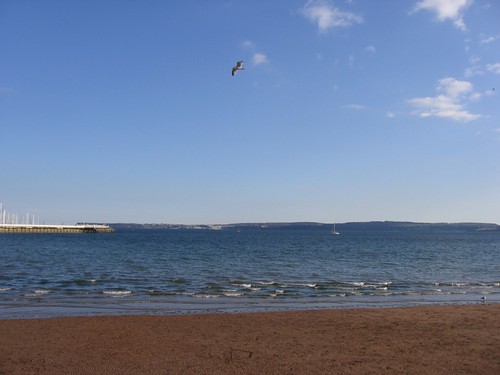Ken Chad started this session by establishing how many in the audience were from libraries, how many from vendors: most were from libraries.
Ken has been doing some work with JISC on the current status of library automation and the growing open source movement in the UK. All attendees are also given a recent article from Cilip Library + Information Gazette.
Ken wanted to talk about the library systems as it is, then look out at issues in the conference, then out to Open Access and Open Access in the library systems market.
Section 1: The Current SituationThe library function is big business:
"...organize the world's information and make it universally accessible and useful.." - Google's mission statement (Ken sees this as
clearly a library statement!)
Conventional libraries have competition: Google has huge revenues and over 1m digitised books (it built its library in reverse - search then collections); Amazon; AbeBooks; LibraryThing (over 20m books catalogued -
"Who would have thought? MARC records to build a social networking site?!"
After 25 years of the library automation market it has matured. At this point basically all systems are the same - the vendors have said as much. It's all a matter of subtle differentiation.
In response to the mature market the LMS vendors are changing their ownsership (indeed almost everyone has in the last 2 years) - Ken gave examples from 2005 up to today. NB: In USA OCLC (who brought Fretwell Downing in 2005) is seen as a library vendor but in the UK it is seen as a commercial enterprise, this is Europe not the US though. Bowker (CIG) owns MediaLabs (Aquabrowser) now... lots of ownership changes.
The role of private equity is important: it's characteristic of a mature market. Private equity forces companies to be leaner, effective and be a growing company. Investment is only in opportunity. One of the reasons is that LMS vendors have been under-performing (especially some of those cooperatives) and therefore not reinvesting in new product. Ownership will change again as current owners sell on in a few years.
Consolidation is also taking place on a big scale - in UK HE 4 (Talis, SirsiDynex, Innovative (most profitable but fewest clients) and Ex-Librisc) companies control 90% of the market. In some countries fewer companies/bigger share. In Sweden Ex-Libris is the only LMS vendor!
These companies can be characterised as doing vertical search. Encore, Primo, Worldcat Local etc. compete with Google by being more relevant to users. Increasingly products are more interoperable with other systems. Also work in new markets - Middle East, China etc.
"The vendors speak" - JISC scoping study 2008
What's influencing the LMS vendors strategies?
- Factors outside the library domain are drivers: Web 2.0, Semantic Web (m2m), Google, Facebook (new spaces and possible decoupling of products - e.g. Primo from Ex-Libris links to other products so wider market potential and more interoperab le)
- New user behaviours
Changing their market offerings:- Vertical search - Encore, Primo, AquaBroswer
- Aggregation - a move to Saas (accessed over the web) and 'platforms' (platform is an extension of brand - e.g. Amazon, Abe, Google, OCLC etc)
- Value in "context", "intentional data" clickstreams (e.g. Amazon gets more useful as you use it more so that it has more context and value for you. Libraries don't do this - but could! They sit on a goldmine of data on what's needed but they don't use it. Herbet mentioned CSU and they are trying a pilot recommender service based on resolver stats) etc. especially in HE
- Universal (Uniform) Resource Management - one system for print and electronic resource etc. ("ExLibris talking most about this at the moment")
However is the market failing?In the US it became the
"OPAC sucks" debate to describe why products were not good and competitive. The concept of market failure is crucial to supporting open source - see report from 2006 Andrew W Mellon Foundation funded report on Open Source.
Duke University Openlib project wants to make a bid to the Andrew W Mellon Foundation to design open source LMS.
Section 2: Emerging Trends and Technology
There is a real change in technology, we need a new strategic approach. Ken recommends work by Yochai Benkler, Professor of Law, Yale Law School. Benkler talks about the networked information economy: there is a new form of production which is social production. Classic example is Linux, built for free! The net can galvanize social production.
"Technology is unleasing a capacity for speaking that before was suppressed by economic constraint. now people can speakl in lots of ways they never before could have, becaouse the economic opportunity was denied to them" - Mother Jones Magazine (website) - Interview waith Lawrence Lessig
Charles Leadbeater, Think Tank Demos, talks of the rise of the "Pro-Am" - it's not amateurish but in the spirit of amateurs. You hear a lot about "The Cathedral and the Bazaar" - the idea that creativity is not only for "special people".
Lessig meanwhile says that copyright is strangling creativity (speech on www.ted.com:
How Creativity is being strangled by the law). Some technology makes copyright as is look absurd.
Open access is a hugely differing business model. Bands such as RadioHead and Crimea gave their albums away for free/allow remixing but make their money from merchandising. Publishers are not happy by this trend although scholarly articles are a slightly different ballgame.
Open source software can be the backing of a commercial business - this new business model is possible. See also: Charles Leadbeater's (free) eText: "We Think. The Future is us" - Profile Books Ltd. 2008
Breakout Session
Comment: The RadioHead example is interesting: 80% of people paid for the download. Also some restaurants charging what they think it's worth still make money.
KC (Ken Chad): Pricing can work on that model: people do have an inate sense of value so will pay for things
Comment: Open source is written by people who you don't know who they are, they may not be there tomorrow. How do you ensure it's sustainable?
Comment (from vendor!): How sustainable is it when people leave companies all the time though!
KC: Sustainability is important. Collaborative nature of open source is crucial. Peer-to-peer collaboration generally means that being modular and having open standards is a characteristic of many open source softwares. Some open source products have maintenance agency (e.g. Linux) and deals with some of those issues.
"It... depends upon copyright law just as Microsoft does: - Lawrence Lessig. "Free Culture", Penguin, 2004.
KC defines open source as free like kittens rather than free like beer. The kittens need looking after, but they are still free.
Open source licensing denies anybody the right to exclusively exploit the work. And OA licensing stops this:
- I cannot copy the work (beyond single personal use)
- I cannot make derivatives of the work
- I cannot authorize anyone else to do anything with the work
Almost everyone uses OA software in critical applications (e.g. Apache). Mozilla had problem with Netscape in the historical issues of licensing (e.g. many elements of something you own may be licensed in ways in which you can't reuse them).
Benefits of Open Source- Bug fixing - "given enough eyeballs, all bugs are shallow"
- Security - you find problems far faster!
- Customization - much easier to do and can pay of develop in-house the add ons as needed and you make use of the social economy.
- Translation - Wikipedia is an example of this, again use of social economy
- Avoiding vendor lock-in - formats tend to be standard and interoperable by design. Much cheaper to change systems too if full retraining and new formats aren't neccassary.
- Mitigation of vendor/product collapse - code isn't owned
- Being part of the community - adopting OA software is on "theological grounds" almost, community support and spirit (e.g. Koha).
Impact of OSS
Big busines snow - adds 263 billion Euros to the European economy
OSS programmers (many in Europe) volunteer at least 800 million Euros worth of labour
Hugely important to Africa, Asia, developing areas etc. either
DiscussionOne Delegate from Adis Ababa commented that his library uses Koha. It has worked well although work has been required in house (this has not been expensive to do).
Comment (from vendor): the Royal Homeopathic Library is using open source and the whole system - including hardware - cost £7000 and it looks super. They have a contract with a support agent
Comment: Liblime act as agent for both Evergreen and Koha OSS
KC again on OSS:
- Some libraries use OSS as a component of library systems
- Perhaps not yet competitive for complete LMS but experience proving otherwise
- "Open Source is about distributed innovation and will become the dominant way of producing software"
OSS LMS Products- Koha
- Evergreen
- Emilda
- Openbiblio
- PMB
UNESCO now have a portal for OSS which is worth seeing and which includes LMS. New companies coming along to support and develop OSS.
Libraries are now migrating from LMS to OSS. However OSS makes the procurement process tricky. How do you demo software or calculate price etc. for OSS. Its a real challenge for those processes. Support and development services will be what you need to procure. This prompted discussions of how this works - effectively you bypass some of that procurement process in orgs.
Richard Gorman, venture partner at Bay Partners (2007): says that it's very difficult as a commercial software vendor to compete with an OSS company - by the time you adjust it may be too late.
Thus OSS challenges the business model by which LMS vendors operate. Some commercial LMS vendors deliver OSS for libraries - e.g. supporting OSS products from others (VTLS), delivering their own OSS products (e.g. Talis) but it's noticable that these are smaller vendors. Maybe the larger vendors are unconcerned when young markets for products still available to sell to.
Concluding thoughts- Technology, cost and complexity barriers are coming down - hugely important
- More open source and open data components and products
- Pro-ams in the library sector
- An increasing contribution from non "traditional" LMS companies
- Copyright clashes will continue - OS is huge threat to IPR
- Libraries are at the heart of the wider culture and technology debate.
Further DiscussionA delegate added that OSS really makes you reexamine what the right tools for the job is and what the role you have actually is now - as librarian, tour guide etc etc.
Another delegate responded that some organisations must work within the bounds of their own systems capabilities. Sometimes you just want a systems supplier who can deal with all the detail for you.
KC: yes, that's what Care Affiliates and Liblime have appeared. It's a very significant change. Takes OS out the "wacky" category and into the mainstream. You need to think of LMS as a tool. Is OS the best way of building software and developing it.
Another delegate asked whether OS was used in other contexts: is it used for payroll?
KC: this is a fair argument but OS is used in VLEs and certainly other contexts if not banking and payroll.
Another delegate added that if a product goes wrong you could sue the vendor if needed though this does not happen in practice very often.
For another delegate it's important that OS allows much faster and more custom development for cheaper.
Further discussion that you can never please everyone! A delegate suggested that you give away the backend and build your own interface, they now use Facebook as their system.
A delegate from Imperial College London are offering Olivia (Online Virtual Information Assistant) for free - if a commercial vendor they would be charging thousands (Bradford have rolled this out as "Lollypop"). We have done podcasts and video as resources BUT the college is wary of uploading to Youtube!
Labels: breakout session A, OPAC, open source











